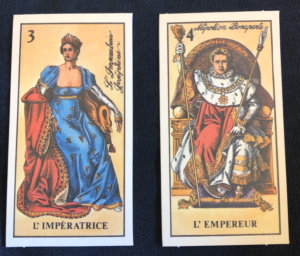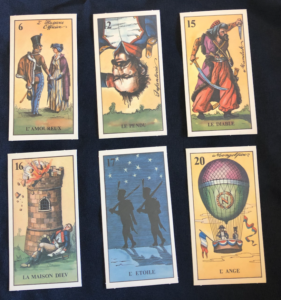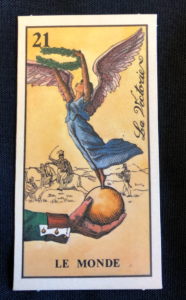Il Tarocco Napoleonica (The Napolean Tarot) by Osvaldo Menegazzi
One of the decks I picked up on my 2019 visit to the Milan studio of Osvaldo Menegazzi, known as Il Meneghello, was the Tarocco Napoleanico, the Tarot of Napoleon. I pulled it out the other night, and realized I had not written about it yet! Today is Bastille Day in France, so this seemed a propitious time to share it.
It is a standard 78-card progression, with 22 Major and 56 Minor Arcana cards.
As Napoleon spent much of his life in the miitary, and is equally famous for being a general as for being an emperor, the deck has a military theme. In addition to the traditional card names (Le Bateleur, La Papesse, L’Etoile, etc.) the cards are labeled with either the name of an historical person, or a general term, such as “Infanterie” (“Infantry”), “Officier” (“Officer”), etc. The pip cards are military medals, one per suit, and labeled with the military order they represent.
Of course, Napoleon and Josephine are the Emperor and Empress cards—the deck is named for him, after all!

[Image description: The Empress and Emperor cards from the Napoleon Tarot, featuring drawings of Josephine and Napoleon.]
The Major cards are wonderfully creative. The Lovers card shows an officer of the Second Hussars and his lady, which brings to mind the folk song, “The Gallant Hussar“.
The Hanged Man card shows an Infantry soldier, which is particularly apt—the enlisted, lowest-level soldier can only do as he is ordered, and has no control over his time, or his life.
The Devil card is a Mameluk warrior; the Mameluks were part of the force which defeated Napoleon’s army in Egypt.
Card 16 bears the traditional name of “La Maison Dieu”, rather than the Tower. The destruction of the holy temple on the card mirrors the destruction of the human body, which is also a Temple of God, in war, as shown by the corpse at the foot of the tower.
L’Etoile, the Star card, shows two soldiers marching in the dark night. The message reads to me as their hopes for the war ending, so they can return home.
Card 20 is “L’Ange”, the “Angel”, rather than Judgment. The picture shows Joseph-Michel and Jacques-Étienne Montgolfier aloft in the hot-air balloon they pioneered, which is delightfully clever!

[Image description: The Lovers, Hanged Man, Devil, Tower, Star, and Angel card from the Napoleon Tarot.]
The World card is labeled “Victory”, and features Napoleon’s hand holding a winged Victory figure on an orb, holding out a laurel crown towards Napoleon. An interesting side note—Appsley House in London, England (the home of the Duke of Wellington, who led the army which defeated Napoleon for the last time) is filled with goods taken from France after the war. One of the items is a large statue of Napoleon holding a similar orb in his hand, but the figure in the statue is flying away from Napoleon. Napoleon did not like the statue, as he felt it was a bad omen—and, well, he was correct.

[Image description: The World card from the Napoleon Tarot.]
The court cards feature various royals of the time—King Charles IV of Spain; Napoleon’s stepdaughter/sister-in-law Hortense de Beauharnais, who became Queen Consort of Holland (her sons included Napoleon III); and Emperor Francis I, among others. All have a connection to Napoleon, of course.
If you are familiar with this period of history, this deck is a fascinating representation of the people and events of the time. If you are not familiar with this era, becoming acquainted with this deck will give you a far-ranging knowledge of it.

Just purchased this deck today in Florence I have 1520/2000. Didn’t know much about the time period reading this has explained alot to me and really enjoyed it! Thank you for your knowledge!
You are most welcome! I’ glad the post was helpful. Enjoy your time in Florence! It’s such a lovely place.